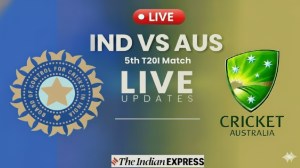WATERY BARRIER
Hogenakkal is at the heart of the latest water dispute between Karnataka and Tamil Nadu. But when the locals communicate, the differences simply get washed away

Hogenakkal is at the heart of the latest water dispute between Karnataka and Tamil Nadu. But when the locals communicate, the differences simply get washed away
Sometimes, the dialect in a border village can cook a snook at a boundary dispute threatening to polarise the people of two states.
In Hogenakkal, a teeming tourist village located 180 km from Bangalore, along the river Cauvery—as it enters Tamil Nadu from Karnataka—strains of Tamil melt into Kannada and touches of Telugu blend in too when locals converse among themselves.
For the tourist, the locals can slip into Tamil, Kannada, English or Telugu depending on where the tourist is from.
“We can speak Tamil and Kannada but we will only carry tourists who come to the Tamil Nadu side of the river. There are boatmen on the Karnataka side, who are also from our village and they only carry tourists from the Karnataka side of the river,” says R. Arumugam, a 24-year-old boatman from Hogenakkal whose family depends on the river for a living.
Over the years, Hogenakkal—or the Smoking Rocks when translated literally and also referred to as the Niagara Falls of India—has had an existence like the quieter hills around it. With the Cauvery as their lifeline, the people of Hogenakkal have traditionally subsisted on a life of fishing, trading in forest produce and small farming.
Once visited only on weekends by a few tourists, the series of waterfalls has over the last five years transformed the village into a major crowd-puller—especially for low-budget tourists from Bangalore, with a steady streams of visitors coming during weekends.
Guiding tourists around the cascading Cauvery has become the primary source of income for Hogenakkal’s families. The tourism potential of Hogenakkal is also believed to be at the heart of the dispute between Karnataka and Tamil Nadu for nearly 67 sq km of land around the village.
Much of the revenue from tourism—the contracts for boating, accessing the main falls, parking and other sundry facilities—trickles into the hands of Tamil Nadu and the Hogenakkal village panchayat since all of Hogenakkal is considered a part of Dharmapuri district in TN.
With accessibility from the Tamil Nadu side better developed, traders from that part usually get most of the various tourism-related contracts. Locals on the Karnataka side also talk of having to pay kickbacks to local politicians to grab some of these contracts each year.
Though seemingly disconnected, the border dispute has invariably merged in with a long-standing dispute between the two states over the sharing of the Cauvery water and is now threatening a TN drinking water project that will pump water from Hogenakkal to towns and villages in the Dharmapuri and Krishnagiri districts of Tamil Nadu.
The drinking water project involves diversion of 1.38 tmc per annum of Cauvery water flowing through Tamil Nadu for the drinking needs of 30 lakh people residing in 17 towns and 6,755 habitations of Krishnagiri and Dharmapuri districts in Tamil Nadu.
Hogenakkal village itself is not listed as a beneficiary of the project and will continue to rely on the river for its needs, say people from the village.
However, on both sides of the border, few people know the true nature of the land dispute. “A few years ago, people from the Karnataka side came and marked out rocks located in Hogenakkal with white paint and said that was the boundary line. But nothing happened after that,” says Murugan, a Hogenakkal resident and guard at the site.
The last time the border dispute over Hogenakkal reared its head was in 2005 when illicit liquor allegedly from the Karnataka side was being sold on Tamil Nadu side. “As ordinary people dependent on the daily earnings from tourists we don’t have anything to do with the dispute. It is all politics being played out on both sides. We only hope that tourists, especially from Bangalore, don’t stop coming here,” says Selva Kumar, a lemonade vendor near the Hogenakkal falls.
In August 2003 and September 2005, the Karnataka government recommended a joint survey of the area to fix the boundaries but elicited no response from the Tamil Nadu side, say officials in Karnataka. Tamil Nadu on its part has maintained that the disputed territory belongs to it.
While the dispute over the sharing of Cauvery has been addressed in courts, the boundary dispute has only been the subject of official communication between the two states.



- 01
- 02
- 03
- 04
- 05




























